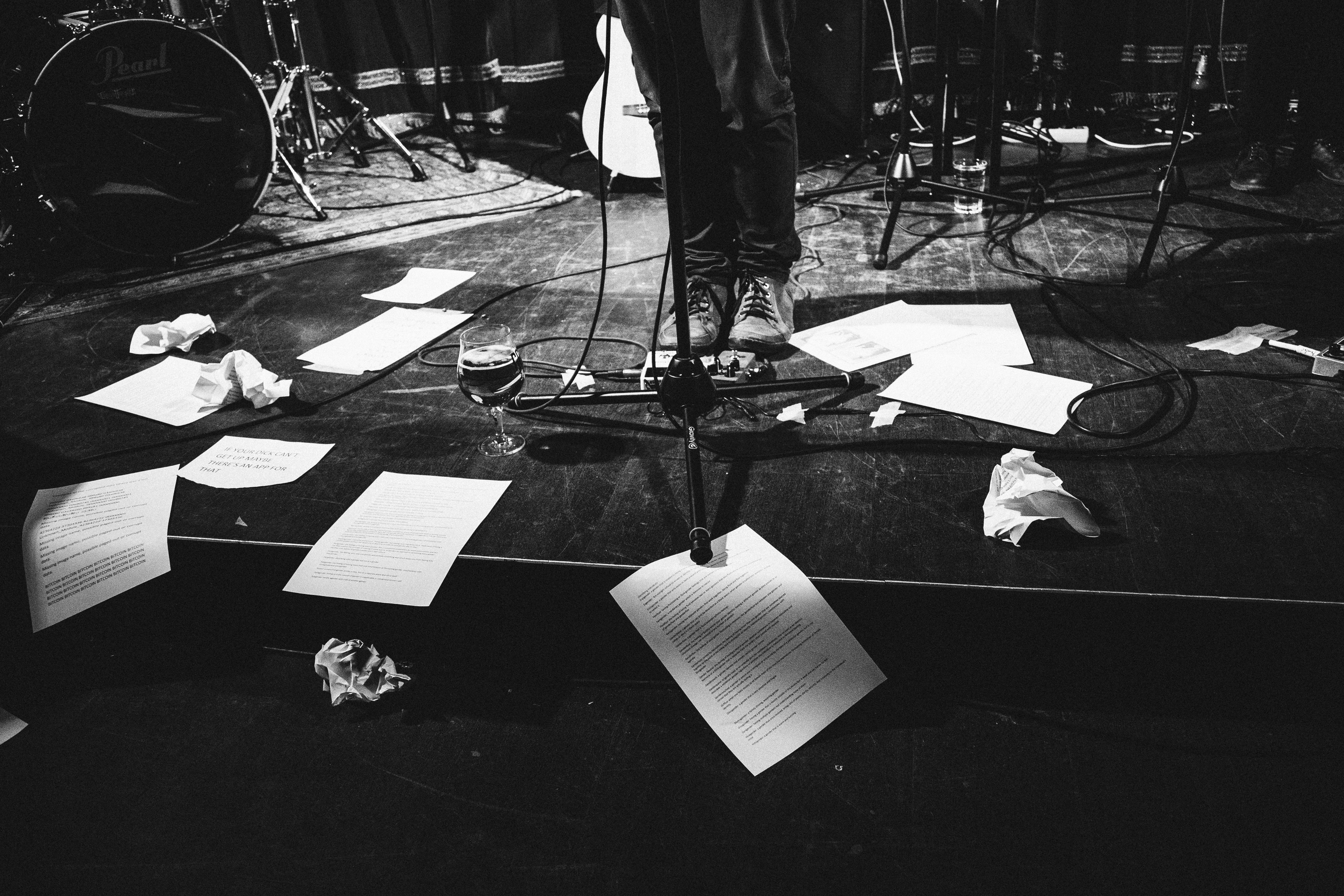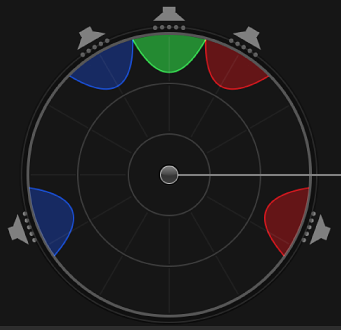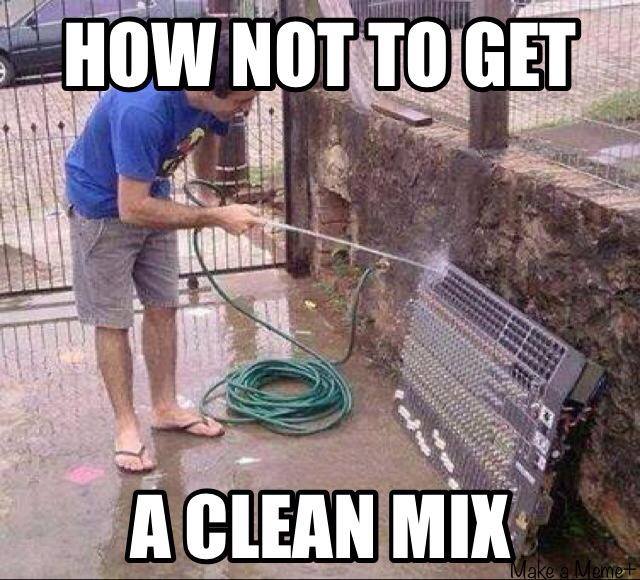HOW TO MIX A LIVE CONCERT / original music
Last week I played a second ever show with my newly formed band. Lucky for us, it went great and it was all recorded pro-channel so we will release our very first live album. I spent a fair amount of time mixing the concert and I noticed my mixing approach was completely different this time around because it was a live show. That got me thinking about mixing live concerts so here are a few tips I learned while trying to mix live shows myself.

(end of the show, shot by the very talented @marinauzelac)
Live shows are music at its best. Live shows are what music was way back before we invented a way to record music and listen to it even when it isn't performed live. Live music is the quintessence of music and, in a way, it's the only part of music that has managed to stay unaffected by the years that went by - we still perform music live, we still want to go see and hear the artist and we even record live shows so we could trick ourselves into feeling the same way we felt at the show, only back at home. That's the reason why mixing a live concert differs from mixing a studio album and why you have to approach mixing in a somewhat different way. And that brings us to tip number one:
ALWAYS REMEMBER IT'S A LIVE SHOW
This might sound silly, but it is very important to always have in mind you're mixing a live show. Live shows, unlike studio work, already have their own panoramas (the spatial layout of the sound; where the sound is coming from in a given space). It is very important to remember that and play around with it. You can either recreate the panoramas how they were on the show (if the drummer was on the left you pan him left, if the lead guitar was on the right you pan it right etc) or you can deliberately turn it all around and make the listener believe it was otherwise. Now, people are mostly noticing those things on a subconscious level and don't think about it while they listen to the music but it plays a very important role in visualising the show and the artist while you listen to the music and since it's a live recording, I always prefer to recreate the panoramas as I heard them from my audience point of view. Of course, you can pan them from the onstage point of view but whatever method you choose, it's important to do it good.

(this is a visual representation of the sound and its sources in space)
CLEAR THE JUNK OUT OF YOUR TRACKS
Studio work tends to get very sterile. You go in there, the room is all covered with foam or other materials that absorb the sound, there's no sound coming from outside, everybody is quiet when recording is taking place, the microphones are all put on the best possible spot and you can use as much microphones to record a certain instrument as you want. Live shows are completely different from that. The venues are mostly not upgraded with sound absorbing materials, there are sounds coming from the outside, nobody is ever quiet, there are bottles rolling on the floor, the microphones are probably not on the best possible place and so on and so on... All of this means you will have a lot of unwanted noise in your recorded tracks. Of course, if you clear everything out, you will loose part of the ambience sound and you will probably loose all of the audience sounds but there's still plenty to cut out to make your life easier. You can always clear out the silence betweenwhen the clapping ends and the next song begins, you can clear out the inbetween buzzes of electric guitars or the cling and the clang of your drummer adjusting his chair after every song etc. That way, it's easier to mix and the unwanted detail don't end up in the show.

ACHIEVE AMBIENCE WITH A PRO-CHANNEL RECORDING
A pro-channel recording means that every element was recorded separately, channel by channel. Pro-channel recording is the predominant method of recording music these days and most people use it both in their home studios, in real studios or live. Although it has its perks (mostly the fact that you can get a separated, strong, clean signal of every component you record separately so you can do whatever you want with it), I'm not a fan of pro-channel recording when it comes to a live show. If you record a live show via a pro-channel methoid, you will end up having a somewhat sterile studio recording of a live show and that is sort of missing the entire point of it. Unfortunately, our show last week was recorded exactly that way so I had to achieve the ''live feel'' later in the mix. There are a few tricks I use to do this. If there were no ambient mics recording the show, you can make your own. You simply export all tracks, then you play them on your speakers, record the sound coming out from the speakers and put them back in the mix. It works as a great substitute for an ambience microphone. You can also ''destroy'' your tracks to make them sound more dirty and more ''live''. For example, I used a lot of distortion on the drums for my mix. There's a slight warm tube distortion on the overheads and on the snare. That makes the drum sound more realistic and even though it sounds too dirty on it's own, it works great in the entire mix because it adds undetectable background noise. I also put a bit of dry reverb on everything (the stereo out) so it gets more of a spatial feel to it. The reverb is impossible to hear but the show ''feels more real'' in the overall sound picture. You can also crank up the ambience from an overhead microphone and center it (rather than pan it left or right) to get more live feel because the overheads are great at getting all the high frequency sounds in the room.

(another shot by @marinauzelac; you can see there are no ambient microphones on stage at the venue, just mics for every individual amp and element)
START FROM THE DRUMS AND WORK YOUR WAY UP
Another problem with mixing a live show are the levels of each track and how to get them right. When you record the pro-channle way, the tracks you get are recorded at volumes the faders were on at the mixer. In other words, if the guitar was fairly loud on stage, the guitar microphone signal was probably low because it was enough to put the guitar in the PA but that level is not loud enough when you mix it. The way to even all the levels out the way they need to be is to start and mix the drum first and use it as your loudness level reference. You get all the drum elements to be at 0dB and then you work your way up. After the drums, I usually mix the level of the bass according to the drums, then the guitars, then other elements and finally vocals. You can work differently, but this is a sure method of getting things leveled out naturally for the listener. Another problem is that many live shows very in dynamics a lot more than a studio recording does. That means you will probably have to tweek the volumes of every element according to every song but make sure it doesn't sound artificial in the final mixdown. That's why it is very important to get good levels at the beginning so you have to tweek them song by song as little as possible. Think of it as a hierarchy pyramid.

RED- drums YELLOW - bass GREEN - guitars and other elements BLUE - vocals
Those are the basic tips of mixing a live concert. Of course, every live show needs an individual approach, but these are some of the universal things you have to think about when mixing any live show. I hope this was helpfull. You can hear our entire show on the embeded link below and I hope you will enjoy it. If you have any questions about this, feel free to ask in the comments and if you have any good advice for me from your own experience, also feel free to comment because I'm open to any new suggestions!
P.S. The mix might very from sound system to sound system etc.
Mixing live shows must indeed be a difficult task. Last years I've been following several bands (such like HVOB) playing at festival stages, mostly at electronic dance festivals. What I noticed, the mixers at these festivals don't know how to set things up, since most of the time the vocals were pushed away, in favour of the bass (bass is pushed a lot at electronic dance music). In a club my best friend almost got into a fight with the mixer guy when she was telling him part of the band (again vocals, and the violin) were in te background and we couldn't hear them properly while at a good spot in front of the band/speakers. Again an electronic band with some acoustic elements to it. This guy belonged to the band, even, but for some reason he was not able to bring the sound of the band into the room in the way it was 'suppose' to. Mixing is not easy, for sure!
I'm not really into electronic music that much and I didn't attend many electronic music shows as it is, but I agree that the mixers mostly don't know how to do their job. I mean, before we had our own guy doing the sound it was a lottery and you never knew who you might end up with and it was mostly bad.
You would think there can be so many good mixers in the world, so many people love music, or do they love the entertainment life more than their work maybe? :)
I think most of them just got tired doing their job so they do it bad and get paid anyway :D